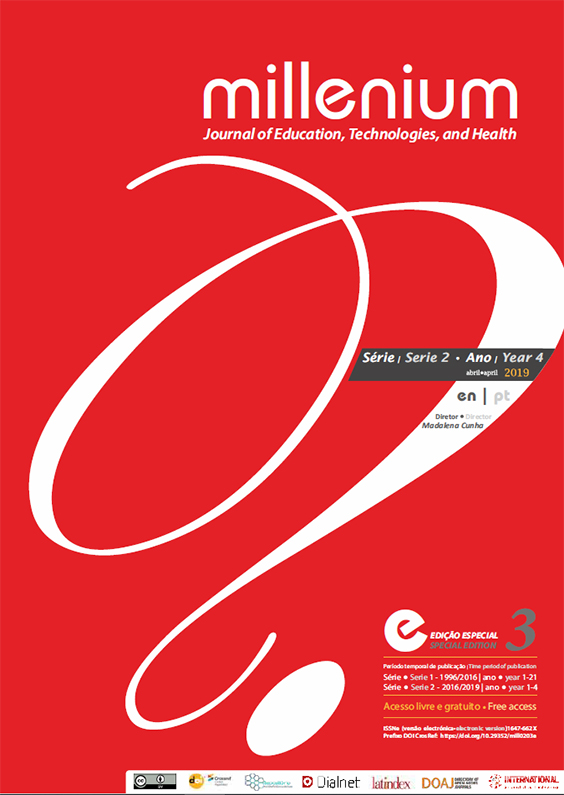A contribuição de uma porção de carne, peixes e ovos para as alterações climáticas
DOI:
https://doi.org/10.29352/mill0203e.02.00191Palavras-chave:
ACV, Alterações climáticas, Roda dos AlimentosResumo
Introdução: A mudança nos padrões alimentares dos cidadãos implicará uma pegada ambiental maior em termos de emissões de gases de efeito estufa e uso de recursos naturais. Por exemplo, dietas ricas em leite e carne, especialmente de ruminantes, estão associadas ao aumento das emissões de metano da fermentação entérica, do dióxido de carbono da deflorestação para dar origem ao pasto e do óxido nitroso da produção de ração.
Objetivos: Para um consumo mais sustentável, o objetivo deste estudo foi quantificar e comparar a contribuição para as alterações climáticas de uma porção do que se come em geral, proveniente da Roda dos Alimentos, relacionados com carnes, aves, peixes e ovos, para alcançar uma dieta equilibrada e saudável.
Métodos: A Avaliação do Ciclo de Vida, baseada nas normas ISO 14040/44 (2006), foi a metodologia utilizada. A análise de inventário e, posteriormente a análise de impacte foram realizadas utilizando o software SimaPro 8.5. O método escolhido para a avaliação de impacte ambiental foi o IPCC 2013 GWP 100a.
Resultados: Os resultados mostram que uma porção de cavala (peixe) apresenta a pegada ecológica inferior seguida da porção de bacalhau, frango, lombo de porco, ovos, lagosta e bife de vaca, respetivamente.
Conclusões: A principal conclusão deste estudo é que a avaliação do impacte de ciclo de vida usando o método IPCC 2013 GWP 100a, pode ajudar as pessoas a escolherem os melhores alimentos para uma refeição mais amiga do ambiente, ajudando a mitigar as alterações climáticas.
Downloads
Referências
Blonk Agri-footprint BV (2017a). Agri-Footprint - Part 2 - Description of data. Gouda, the Netherlands.
Blonk Agri-footprint BV (2017b). Agri-Footprint - Part 1 - Methodology and basic principles. Gouda, the Netherlands.
DGC/FCNAUP (2003). A nova RODA DOS ALIMENTOS, um guia para uma escolha alimentar diária. Direção-Geral do Consumidor / FACULDADE DE CIÊNCIAS DA NUTRIÇÃO E ALIMENTAÇÃO DA UNIVERSIDADE DO PORTO. Accessed in: http://www.fao.org/3/a-ax433o.pdf
DGS/DGC (2014). DIA ALIMENTAR COMPLETO, EQUILIBRADO E VARIADO. Direção-Geral do Consumidor / Direção Geral de Saúde. Accessed in: http://www.fao.org/3/a-ax434o.pdf
Ferreira, J. and Domingos, I. (2011). Assessment of Portuguese Thermal Building Legislation in an Energetic and Environmental Perspective. Energy and Buildings, Vol. 43, Issue 12, 3729-3735. https:/doi.org/10.1016/j.enbuild.2011.09.007
Ferreira, J., Viana, H., Esteves, B., Cruz-Lopes, L., Domingos, I. (2014). Life cycle assessment of residual forestry biomass chips at a power plant: a Portuguese case study. International Journal of Energy and Environmental Engineering, 5, Issue 2-3, 1-7. https:/doi.org/10.1007/s40095-014-0086-4
Ferreira, J., Esteves, B., Nunes, L., Domingos, I. (2016). Life Cycle Assessment as a tool to promote sustainable Thermowood boards: a Portuguese case study. International Wood Products Journal, 7, Issue 3, 124-129. https:/doi.org/10.1080/20426445.2016.1160592
Ferreira, J., Esteves, B., Cruz-Lopes, L., Evtuguin, D., Domingos, I. (2018). Environmental advantages through producing energy from grape stalk pellets instead of wood pellets and other sources. International Journal of Environmental Studies. DOI: 10.1080/00207233.2018.1446646
FAO (2017). The future of food and agriculture – Trends and challenges. Rome. Accessed in: http://www.fao.org/3/a-i6583e.pdf
International Standard Organisation (2006 a). EN ISO 14040:2006. Environmental management – Life cycle assessment – principles and framework. International Standard Organisation (eds), Geneva, Switzerland, pp. 28.
International Standard Organisation (2006 b). EN ISO 14044:2006. Environmental management – Life cycle assessment – requirements and guidelines. International Standard Organisation (eds), Geneva, Switzerland, pp. 46.
IPCC, 2013: Climate Change 2013: The Physical Science Basis. Contribution of Working Group I to the Fifth Assessment Report of the Intergovernmental Panel on Climate Change [Stocker, T.F., D. Qin, G.-K. Plattner, M.
Tignor, S.K. Allen, J. Boschung, A. Nauels, Y. Xia, V. Bex and P.M. Midgley (eds.)]. Cambridge University Press, Cambridge, United Kingdom and New York, NY, USA, 1535 pp.
Nemecek, T. and Kägi, T. (2007). Life cycle inventories of agricultural production systems. Ecoinvent report version 2.0. Editors: 0. Volume: 15. Swiss Centre for LCI, ART. Dübendorf and Zurich, Switzerland.
Nielsen, PH., Nielsen, AM., Weidema, BP., Dalgaard, R., Halberg, N. (2003). LCA food database. Accessed in: www.lcafood.dk.
PRé, various authors, (2017). SimaPro Database Manual, Methods Library, Report version 3.0, May 2017, PRé Consultants, Netherlands. Accessed in: https://www.pre-sustainability.com/
UN (2015). Transforming our world: the 2030 Agenda for Sustainable Development. United Nations, General Assembly Resolution A/RES/70/1. New York, USA. Accessed in: https://sustainabledevelopment.un.org/post2015/transformingourworld
UNFCCC (2015). United Nations Framework Convention on Climate Change. Adoption of the Paris Agreement. UN document FCCC/CP/2015/L.9/Rev.1. New York, USA.
Werner, F., Althaus, H., Kunninger, T., Richter, K., Jungbluth, N. (2007). Life Cycle Inventories of Wood as Fuel and Construction Material. Ecoinvent report No 9, EMPA Duebendorf Swiss Centre for Life Cycle Inventories, Dubendorf, CH.
Downloads
Publicado
Como Citar
Edição
Secção
Licença
Os autores que submetem propostas para esta revista concordam com os seguintes termos:
a) Os artigos são publicados segundo a licença Licença Creative Commons (CC BY 4.0), conformando regime open-access, sem qualquer custo para o autor ou para o leitor;
b) Os autores conservam os direitos de autor e concedem à revista o direito de primeira publicação, permitindo-se a partilha livre do trabalho, desde que seja corretamente atribuída a autoria e publicação inicial nesta revista.
c) Os autores têm autorização para assumir contratos adicionais separadamente, para distribuição não-exclusiva da versão do trabalho publicada nesta revista (ex.: publicar em repositório institucional ou como capítulo de livro), com reconhecimento de autoria e publicação inicial nesta revista.
d) Os autores têm permissão e são estimulados a publicar e distribuir o seu trabalho online (ex.: em repositórios institucionais ou na sua página pessoal) já que isso pode gerar alterações produtivas, bem como aumentar o impacto e a citação do trabalho publica
Documentos necessários à submissão
Template do artigo (formato editável)





